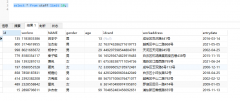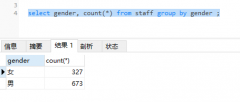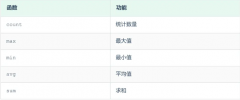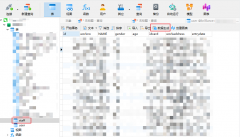Are SELECT FOR XML querys slow?(SELECT FOR XML 查询速度慢吗?)
问题描述
我有一个存储过程,它使用 SELECT FOR XML PATH 语句将 XML 返回给调用者.随着更多行被添加到查询的主表中,我注意到此查询的性能有所下降.
I have a stored procedure which returns XML to the caller using a SELECT FOR XML PATH statement. As more rows have been added to the main table in the query I have noticed that the performance of this query has degraded.
经过调查,我发现在没有 FOR XML 语句的情况下在 SQL management studio 中运行查询所需的时间是 FOR XML 查询所需时间的 1/3.由 FOR XML 调用的 XML 生成是否有很大的开销,或者在使用 FOR XML 时有哪些应该做和不应该做的事情.
On investigation I found that running the query in SQL management studio without the FOR XML statement takes the 1/3 of the time the FOR XML query takes. Is the XML generation that is invoked by FOR XML that much of an overhead or are there some do's and don't s when using FOR XML.
下面是我的表定义和使用的返回 > 3000 行的查询.已更改列名称以保护无辜者.
Below is my table definition and the query used which returns > 3000 rows. The column names have been changed to protect the innocent.
欢迎任何建议.
CREATE TABLE dbo.results
(
colA int NOT NULL,
colB varchar(20) NULL,
colC varchar(30) NULL,
colD varchar(100) NULL,
colE char(3) NULL,
colF int NULL,
colG int NULL,
colH datetime NULL,
colJ int NULL,
colK int NULL,
colL int NULL,
colM int NULL,
colN int NULL,
colO int NULL,
colP int NULL,
colQ int NULL,
colR int NULL,
colS int NULL,
colT int NULL,
colU int NULL,
colV int NULL,
colW int NULL,
colX int NULL,
colY datetime NULL,
colZ int NULL,
colA1 datetime NULL,
colB1 int NULL,
colC1 int NULL,
colD1 int NULL,
colE1 int NULL,
colF1 int NULL,
colG1 int NULL,
colH1 int NULL,
colI1 int NULL,
colK1 int NULL,
colL1 int NULL,
colM1 int NULL,
colN1 int NULL,
colO1 int NULL,
colP1 int NOT NULL,
colQ1 int NOT NULL,
colS1 int NULL,
colT1 int NULL,
colU1 int NULL,
colV1 int NULL,
colW1 int NULL,
colX1 int NULL,
colY1 int NULL,
colZ1 datetime NULL
CONSTRAINT results_pk PRIMARY KEY CLUSTERED
(
colA ASC
)
WITH (PAD_INDEX = OFF,
STATISTICS_NORECOMPUTE = OFF,
IGNORE_DUP_KEY = OFF,
ALLOW_ROW_LOCKS = ON,
ALLOW_PAGE_LOCKS = ON)
ON PRIMARY)
查询:
select colA "@A",
colB "@B",
colC "@C",
colD "@D",
colE "@E",
colF "@F",
colG "@G",
colH "@H",
colJ "@J",
colK "@K",
colL "@L",
colM "@M",
colO "@O",
colN "@N",
colP "@P",
colQ "@Q",
colR "@R",
colZ1 "@Z1",
colS "@S",
colT "@T",
colU "@U",
colV "@V",
colW "@W",
colX "@X",
colY "@Y",
colP1 "@P1",
colQ1 "@Q1",
colO1 "@O1"
from result
order by colO desc , colC
for xml PATH('item'), TYPE
推荐答案
只是为了确保您没有将客户端渲染时间计入等式,将结果分配给一个变量并查看执行时间是否相同.这是我刚刚在服务器上运行的示例:
Just to make sure that you're not taking client rendering time into the equation, assign the result to a variable and see if the execution time is the same. Here's an example I just ran on my server:
SET STATISTICS TIME ON
go
DECLARE @x XML
PRINT '------------'
SELECT @x =
(SELECT * FROM sys.[dm_exec_connections] AS dec
FOR XML PATH('connections'), TYPE)
PRINT '------------'
SELECT * FROM sys.[dm_exec_connections] AS dec
FOR XML PATH('connections'), TYPE
这是结果(查看执行时间):
And here are the results (looking at the execution times):
SQL Server parse and compile time:
CPU time = 0 ms, elapsed time = 0 ms.
SQL Server Execution Times:
CPU time = 0 ms, elapsed time = 0 ms.
SQL Server parse and compile time:
CPU time = 0 ms, elapsed time = 87 ms.
------------
SQL Server Execution Times:
CPU time = 0 ms, elapsed time = 34 ms.
SQL Server Execution Times:
CPU time = 0 ms, elapsed time = 2 ms.
------------
SQL Server Execution Times:
CPU time = 0 ms, elapsed time = 0 ms.
(1 row(s) affected)
SQL Server Execution Times:
CPU time = 15 ms, elapsed time = 884 ms.
将其放入变量需要 34+2=36 毫秒,而将其转储到我的屏幕需要 884 毫秒.这是一个很大的不同!
Putting it in a variable took 34+2=36 ms whereas dumping it to my screen took 884. That's quite a difference!
这篇关于SELECT FOR XML 查询速度慢吗?的文章就介绍到这了,希望我们推荐的答案对大家有所帮助,也希望大家多多支持编程学习网!
本文标题为:SELECT FOR XML 查询速度慢吗?


基础教程推荐
- MySQL根据从其他列分组的值,对两列之间的值进行求和 2022-01-01
- MySQL 5.7参照时间戳生成日期列 2022-01-01
- CHECKSUM 和 CHECKSUM_AGG:算法是什么? 2021-01-01
- ORA-01830:日期格式图片在转换整个输入字符串之前结束/选择日期查询的总和 2021-01-01
- 从字符串 TSQL 中获取数字 2021-01-01
- 使用 VBS 和注册表来确定安装了哪个版本和 32 位 2021-01-01
- 如何在 CakePHP 3 中实现 INSERT ON DUPLICATE KEY UPDATE aka upsert? 2021-01-01
- 带更新的 sqlite CTE 2022-01-01
- 带有WHERE子句的LAG()函数 2022-01-01
- while 在触发器内循环以遍历 sql 中表的所有列 2022-01-01

















